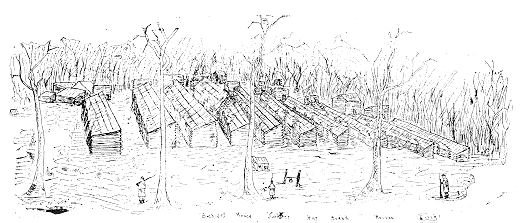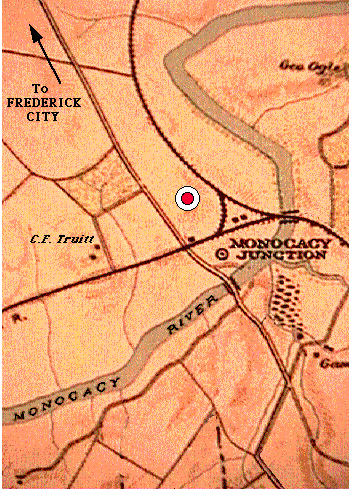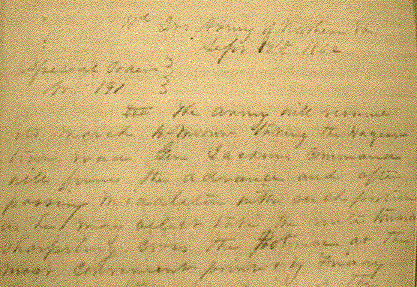

Special Orders 191 was the general order written by Confederate General Robert E. Lee to begin his Maryland Campaign in Septemebr of 1862. An original copy was lost and then later found by soldiers of the 27th Indiana. The result was a failed invasion for Lee, far-reaching political consequences for the South, and the bloody battle of Antietam.
To find out who Found the order, stay on this page. To find out who Lost the Lost Order, GO here
The following excerpt, less illustrations, is from "Giants in the Cornfield: The 27th Indiana Infantry," by Wilbur D. Jones, pp 229-233. It is protected by copyright and is used with permission of the author.
Saturday, September 13th, 1862.
Early a.m. Up before dawn, the XII Corps marched westward toward Frederick. The 27th went past the familiar William Clay and William Hoffman houses in Bartonsville and through the area of deserted cabins they had occupied the winter before. They learned the bulk of Lee's army had been in Frederick until recently, and the Federals might encounter cavalry or outposts. One member recalled they always felt secure there, but "sudden and violent changes which fortunes of war may bring" had changed that.

The 27th formed the corps' skirmish line because of their knowledge of the area, and advanced between Urbana and New Market. Reaching the narrow and knee-deep Monocacy River two miles east of town, the 27th waded across at Crum's (Reich's) Ford, fanned out through the woods down the river to the south, and turned back toward the city. Company F skirmishers, commanded by [First Sergeant John M.] Bloss, were in the van. They rapidly reached the suburbs where the converging lines of the other units caused them to halt.

9:00 a.m. Bloss ordered his line to rest in a clover field two miles south of Frederick which had been recently occupied by a large force, undoubtedly Confederates. They stopped several hundred yards above the river and 100 yards to the east of the Georgetown turnpike into Washington, near where the Baltimore and Ohio spur from Frederick intersects the main line. They discerned no movement ahead but saw artillery smoke rising west of town. The day was beautiful and warm, and the weary Hoosiers slumped to the ground in the shade on a relatively unspoiled grassy slope near a rail fence and bushes, speculated on the former occupants, and drank from canteens. In a group of four men, Bloss was on the right of the three lying down, with Corporal Barton Warren Mitchell in the center, Private David Bur Vance on the left and Private William H. Hostetter [Company A] a few feet behind and to the right of Bloss.

|

|

|

|

|

|
|
|
|
|
|
|
|
Bloss and Mitchell conversed. Within a minute after halting, Bloss noticed a yellowish paper package lying in the grass between Vance and Mitchell. "What is it Mitchell?" Bloss asked. "An envelope," was the reply. "Hand it to me," Bloss said. Vance picked up the unsealed package, and, as he passed it over Mitchell's body to Bloss, out fell three small cigars. Inside was a folded two-page letter. Mitchell certainly knew what those were and fondled and playfully divided the cigars, then sought a match to smoke one. Bloss, glancing at the document, told Mitchell to wait until he had read the letter. Bloss then read it aloud to Mitchell, Vance and others, including Hostetter, Privates Joseph Dunn Laughlin [Company B], John Campbell, George Washington Welsh, and Enoch G. Boicourt. As he read it "each line became more interesting," and he forgot the cigar.


|

|
|
|
|
Carefully emphasizing key names and words, Bloss was dumbfounded: Marching orders "giving plans for the next four days from that time" for all of Lee's army. If true, the information was extremely important. It had to be real. But why are they here? The bystanders were stunned and mumbled to each other. Mitchell again asked for a match, but Bloss told him to stuff the cigars back in the envelope and give them to him. "Boys," Bloss said, "this is of great importance, if genuine. I will take it to Captain Kop [Company F commander]. Then"the order created a general fusillade among the soldiers and excitement over the joy of the information."
9:10 a.m. Bloss relinquished command of his unit temporarily and alone with the package headed for Kop, not a hundred yards away. Kop read the order quickly and agreed with Bloss: the colonel must see it immediately.
9:30 a.m. On foot, Kop and Bloss located Colonel Silas Colgrove, the regiment's commander, less than a half mile distant. Bloss handed the package to Colgrove who read the order and saw the three cigars. Up rode Brigadier General Nathan Kimball, and he also read it. Kimball suggested Colgrove bypass his brigade headquarters and go directly to Brigadier General Alpheus Starkey Williams, the acting XII Corps commander. Kop and Bloss returned to their men. The cigars disappeared, their fate unknown, but their role in history and lore secured.

|

|

|

|

|

|
|
|
|
|
|
|
|
9:45 a.m. Kimball and Colgrove rode to Williams' headquarters. He was not there, so they reported the find to Captain Samuel E. Pittman, his assistant adjutant general. "I immediately identified the signature of Colonel R.H. Chilton, Lee's Assistant Adjutant General," Pittman stated. Before the war, Pittman was a teller with the Michigan State Bank in Detroit, and Chilton was the paymaster for the army stationed there. As the signature expert, Pittman knew Chilton's, and with luck for the Federals, proved it was no "ruse de guerre." The signature and the orders thus were genuine. But Pittman had to await Williams' return before forwarding the papers.
10:30 a.m. Pittman took Colgrove and reported to Williams with the order, Kimball accompanying. Williams directed Pittman to "lose no time in placing it in General McClellan's possession." Pittman "could not be spared" to deliver the papers, as a movement was expected. So he wrote a note for Williams to sign and sent a "trusty courier" to "ride fast" with the orders and note to McClellan's assistant adjutant general. The Williams note, one of two contemporary records of the find, read: "I enclose a Special Order of General Lee, commanding rebel forces, which was found on the field where my corps is encamped. It is a document of interest and is also thought to be genuine." Pittman was "about to copy the paper itself, recognizing that the finding of such an important document was likely to become an interesting fact of history, but General Williams would not permit a moment's delay." Colgrove returned to his regiment and Kimball accompanied the courier.
12:00 noon. Major General Randolph B. Marcy, McClellan's chief of staff, took the papers to McClellan. Told they had been found by an Indiana soldier on the grounds vacated by Lee's men, and with Chilton's signature verified, McClellan was satisfied that the orders were genuine and made no further inquiries. At the time meeting with a group of Frederick citizens, he excitedly opened the papers, read them them silently, and hardly believed his eyes--and his luck. The orders corroborated his intelligence reports: Lee had divided his forces. He exclaimed, "Now I know what to do!"
1:00 p.m. Within an hour after McClellan had the papers "the army was in motion, the lead troops in advance," orderlies and staff officers "flying in all directions." Progress thereafter was slow, but many troops began departing from the hastily assembled Frederick campsite, although the 27th Indiana would not leave until later. Armed with that extraordinary information, the Federals would now test the viability and execution of Lee's orders and attempt to destroy the Rebel forces.
With little dissent, history has anointed Corporal (not Private as some have written) Mitchell as the finder of the Lost Order, and Bloss as a bystander. Vance and Hostetter are not mentioned. But because Bloss, Mitchell and Vance each played a role in seeing, retrieving, and forwarding the Lost Order, each must be credited as a finder. Who first saw the package is forever arguable and of little consequence to either the outcome, Lee's defeat at Antietam, or one of the most intriguing mysteries of the war, who lost it. To slight any of them would levy an historic disservice, but if one is allowed to be the most important finder, it would have to be Bloss.....
......Bloss was the best educated, most credible, and most apt to recognize their fortuitous coup. Seeing the envelope, the initial action, was pure chance. Picking it up and examining it, the next step, was logical, but really the inquisitiveness of bored soldiers. Reporting it up the chain of command, however, was the product of intelligence and initiative. Bloss was the regiment's only college graduate (Hanover) and eventually its most successful survivor. He rose from sergeant to captain and commanded Company F in 1864. Wounded at Winchester, Antietam, Chancellorsville and Resaca, he completed his term and was mustered out in October 1864. A career educator, he was a teacher, principal, Evansville superintendent of schools, Indiana State superintendent, and president of Oregon State University.
HEADQUARTERS, ARMY OF NORTHERN VIRGINIA
September 9th, 1862
Special Orders, No. 191 }
III. The Army will resume its march to-morrow, taking the Hagerstown road. General Jackson's command will form the advance, and after passing Middletown, with such portions as he may select, take the route toward Sharpsburg, cross the Potomac at the most convenient point, and by Friday night take possession of the Baltimore and Ohio Railroad, capture such of the enemy as may be at Martinsburg, and intercept such as may attempt to escape from Harper's Ferry.
IV. General Longstreet's command will pursue the same road as far as Boonsboro', where it will halt with the reserve, supply, and baggage trains of the army.
V. General McLaws with his own division and that of General R.H. Anderson, will follow General Longstreet; on reaching Middletown he will take the route to Harper's Ferry, and by Friday morning possess himself of the Maryland Heights and endeavor to capture the enemy at Harper's Ferry and vicinity.
VI. General Walker, with his division after accomplishing the object in which he is now engaged, will cross the Potomac at Check's ford, ascend its right bank to Lovettsville, take possession of Loudoun Heights, if practicable, by Friday morning, Keyes's ford on his left, and the road between the end of the mountain and the Potomac on his right. He will, as far as practicable, cooperate with General McLaws and General Jackson in intercepting the retreat of the enemy.
VII. General D.H. Hill's division will form the rear guard of the army, pursuing the road taken by the main body. The reserve artillery, ordnance, and supply trains, etc., will precede General Hill.
VIII. General Stuart will detach a squadron of cavalry to accompany the commands of Generals Longstreet, Jackson, and McLaws, and, with the main body of the cavalry, will cover the route of the army and bring up all stragglers that may have been left behind.
IX. The commands of Generals Jackson, McLaws, and Walker, after accomplishing the objects for which they have been detached, will join the main body of the army at Boonsboro' or Hagerstown.
X. Each regiment of the march will habitually carry its axes in the regimental ordinance-wagons, for use of the men at their encampments, to procure wood, etc.
By command of General R.E. Lee.
R. H. Chilton, Assistant Adjutant-General.
Major-General D.H. Hill, Command Division.
To find out who Lost the Lost Order, GO here
For comments or suggestions about Lee's lost order, e-mail Steve Russell